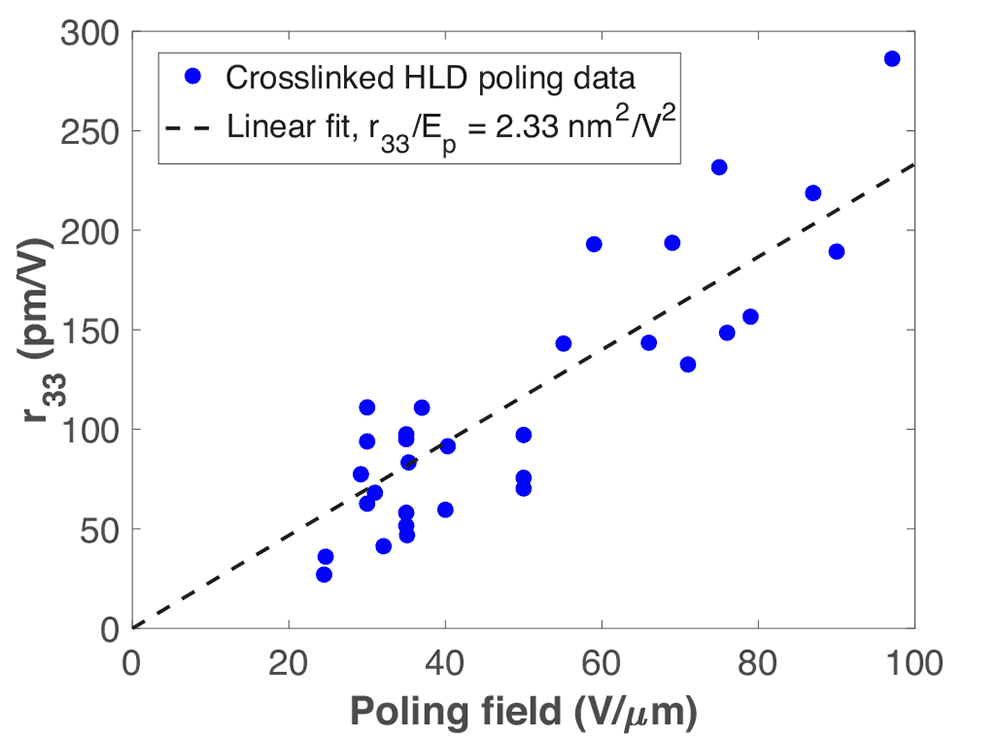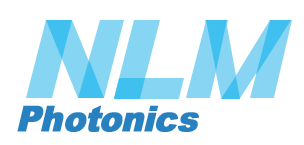NLM’s premier organic nonlinear optical materials with high electro-optic effects.
Our organic electro-optic (OEO) material products, HLD and JRD1, are produced, validated, and supported by the NLM team and available under evaluation/R&D or commercial licenses. They are the world’s highest-performing EO materials, enabling record bandwidth (speed) and power efficiency in EO components.
Our materials bring a long history of R&D at the University of Washington to the market. They allow components to run 100x faster than standard microprocessors and use 1000x less power than competing solutions.
At NLM, and with our partners and customers, we’re continuously advancing hybrid OEO technologies to revolutionize computing and communications. Our materials are available today and will push technological innovation and help us build a more sustainable future.
Advantages of NLM’s OEO materials
- Better stability, as the Pockels effect yields a linear and chirp-free response.
- Improved intrinsic bandwidth due to inherently ultrafast response time of OEO (electronic displacement) compared to incumbent inorganic materials like LiNbO3 (atomic displacement).
- Higher electro-optic activity, up to 10x that of incumbent inorganic material LiNbO3, enabling smaller devices and lower drive voltages, with voltage-length products (VπL) in the 50-500 V-μm range.
- Small device footprints possible (<10 μm2), allowing for in-chip implementation and no significantly increased device bulk.
- Lives up to current and future demands with ultrafast responses and large bandwidths (> 500 GHz demonstrated for related materials).
EO modulators exhibiting the Pockels effect are typically used when converting electrical signals to optical signals within optical telecommunication networks. Hybrid EO technology composed of organic materials and silicon device architecture leverages the large EO response of organic chromophores. Additionally, small device sizes are enabled by silicon on insulator (SOI) fabrication. Organic EO materials have achieved record bandwidths and switching speeds when implemented in hybrid devices, as well as energy efficiencies on the order of 100 aJ/bit.
Applications for HLD and JRD1
While computing changes and grows, here are some already identified industry applications for them:
- Telecommunications
- Optical networking
- Optical computing
- RF photonics
- Optical neural networks
- Antennas
- Terahertz radiation sources/detectors
Device types ready for HLD and JRD1 integration:
- Plasmonic-organic hybrid (POH) devices
- Silicon-organic hybrid (SOH) devices
- Phase, Mach-Zehnder, and IQ modulators
- Frequency combs and beam steering
- Optical frequency mixers (antennas)
HLD
HLD is a high-performing organic electro-optic material with superior thermal stability suitable for commercial applications. It has up to 10X the electro-optic activity (r33) of lithium niobate (LiNbO3), is solution-processable, and contains no rare earth metals. The performance and stability of NLM’s HLD are available to integrate with your technology and devices today.
Advantages of NLM’s HLD
HLD materials will improve your current technologies and make way for future innovations.
- The thermoset plastic exhibits exemplary thermal stability, with no drop in r33 after 2,000 hours of shelf storage at 85 °C in an inert environment. Inert shelf storage at higher temperatures, up to 120 ˚C, produces only a small initial “burn-in” (5-20%) followed by stable performance. Device operation has been demonstrated up to 140 °C for brief periods, enabling use in demanding thermal environments.
- Crosslinked material is resistant to many common solvents. This resistance allows other processing steps — such as depositing other materials, photolithography, cleaning, etching, encapsulation, etc. — to happen without dissolving the EO material.
- Crosslinking technology to preserve acentric order for locked-in, stable performance.
Thermal stability during 2,000-hour inert shelf storage at 85/105/120 °C

Electro-optic activity with crosslinking

Physical properties of HLD
- Electro-optic coefficient (r33) at 1310 nm:
- Up to 460 pm/V without crosslinking (in a parallel plate configuration)
- Up to 290 pm/V with crosslinking (in a parallel plate configuration)
- Refractive index at 1550 nm (from VASE) before crosslinking = 1.88 – 1.89
- Refractive index at 1550 nm (from VASE) after crosslinking = 1.83 – 1.85
- Absorption (k) at 1550 nm (from VASE) before crosslinking < 0.0001
- Absorption (k) at 1550 nm (from VASE) after crosslinking < 0.0002
- Thermal stability: > 2000 hours at 120 °C (long-term), up to 140 °C (short-term)
- Td > 250 °C
- HLD1 Tg (before-crosslinking): 75-90 °C
- HLD2 Tg (before-crosslinking): 72-80 °C
- Poling temperature: 95 °C (after pre-crosslink)
- Crosslinking temperature range: 105-160 °C
- Tg = ~155-165 °C and = 175 °C under optimal conditions
- Thin film absorption maximum (λmax): 782 nm
- Hyperpolarizability (β) in CHCl3: 2120 ± 50 x 10-30 esu at 1300 nm
JRD1
Truly a workhorse, JRD1 is an OEO material with record-high electro-optic activity, over 10x that of LiNbO3. JRD1 was first reported in 2014. It has been extensively studied, with citations in over 50 papers, and has been used in many different device designs. Its excellent solubility affords facile processing and ensures fast results in prototyping new devices and applications.
Advantages of NLM’s JRD1
Here’s how JRD1 materials will advance your current technologies and pave the way for future innovations.
- Easy-to-use: the solution is processable in an array of solvents.
- Relatively inexpensive and affordable when compared to other OEO materials.
- Extensive literature on device applications means JRD1’s proven record gives your applications a head start.
Physical properties of JRD1
- Electro-optic coefficient (r33):
- Up to 390 pm/V in a silicon-organic hybrid device at 1550 nm
- Up to 556 pm/V in a parallel plate configuration at 1310 nm
- Refractive index at 1550 nm (from VASE) = 1.83 – 1.85
- Thin film absorption maximum (λmax): 800 nm
- Hyperpolarizability (β) in CHCl3 at 1300 nm: 3330 x 10-30 esu ± 50 x 10-30
- Thermal stability: < 50 °C
- Td: 226 °C
- Poling temperature: ~85-90 °C
- Tg: 82 °C
HLD or JRD1 for your project?
Both HLD and JRD1 are easy to work with and highly soluble in a wide range of solvents. The first thing to consider is your thermal needs and where you are in your product development. The major difference between the materials is that HLD contains chemical functionalities that allows it to crosslink (polymerize), forming a durable and thermally stable film. JRD1 does not contain these groups, which reduces cost and simplifies processing, but restricts application to operations at less than ~50 °C. HLD offers stability at much higher temperatures with a maximum operating temperature of ~140 °C and long-term stability at > 85 °C, enabling long-term use under demanding thermal conditions. JRD1 is comparatively lower-cost and enables somewhat higher EO performance.
Of course, we are happy to help you determine the best options for you and your application.
References
HLD references:
Xu, H.; Liu, F.; Elder, D. L.; Johnson, L. E.; de Coene, Y.; Clays, K.; Robinson, B. H.; Dalton, L. R., Ultrahigh Electro-Optic Coefficients, High Index of Refraction, and Long-Term Stability from Diels–Alder Cross-Linkable Binary Molecular Glasses. Chemistry of Materials 2020, 32, 1408-1421. Doi: 10.1021/acs.chemmater.9b03725
Johnson, L. E.; Elder, D. L.; Xu, H.; Hammond, S. R.; Benight, S. J.; O’Malley, K.; Robinson, B. H.; and Dalton, L. R.. Proc. SPIE 11812. 2021, Molecular and Nano Machines IV (1181202). Doi: 10.1117/12.2595638
Koch, U.; Uhl, C.; Hettrich, H.; Fedoryshyn, Y.; Hoessbacher, C.; Heni, W.; Baeuerle, B.; Bitachon, B. I.; Josten, A.; Ayata, M.; Xu, H.; Elder, D. L.; Dalton, L. R.; Mentovich, E.; Bakopoulos, P.; Lischke, S.; Krüger, A.; Zimmermann, L.; Tsiokos, D.; Pleros, N.; Möller, M.; Leuthold, J., A monolithic bipolar CMOS electronic–plasmonic high-speed transmitter. Nature Electronics 2020. Doi: 10.1038/s41928-020-0417-9
JRD1 references:
Jin, W.; Johnston, P. V.; Elder, D. L.; Tillack, A. F.; Olbricht, B. C.; Song, J.; Reid, P. J.; Xu, R.; Robinson, B. H.; Dalton, L. R., Benzocyclobutene barrier layer for suppressing conductance in nonlinear optical devices during electric field poling. Applied Physics Letters 2014, 104, 243304. Doi: 10.1063/1.4884829
Jin, W.; Johnston, P. V.; Elder, D. L.; Manner, K. T.; Garrett, K. E.; Kaminsky, W.; Xu, R.; Robinson, B. H.; Dalton, L. R., Structure–function relationship exploration for enhanced thermal stability and electro-optic activity in monolithic organic NLO chromophores. J. Mater. Chem. C 2016, 4, 3119-3124. Doi: 10.1039/c6tc00358c
Kieninger, C.; Kutuvantavida, Y.; Wolf, S.; Zwichel, H.; Blaicher, M.; Kemal, J.; Elder, D. L.; Lauermann, M.; Dalton, L. R.; Freude, W.; Randel, S.; Koos, C., Ultra-high electro-optic activity demonstrated in a silicon-organic hybrid modulator. Optica 2018, 5, 739-748. Doi: 10.1364/OPTICA.5.000739
See our Documentation and Publications for further scientific information about our products, platform, and R&D.

